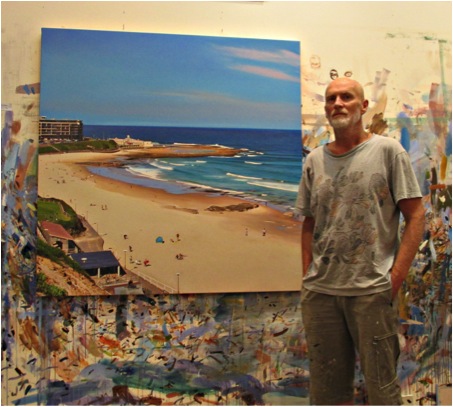John Earles Painter - Merewether, NSW, Australia
You are the ‘Australian Man’, born and breed in Newcastle. Do you ever tire of your country?
We can all tire a little of the environment which we see every day. It is hard to tire of the ever changing NSW coastline, especially Newcastle. Newcastle is my favourite city anywhere. It is a cultural centre, as are most cities, but doesn’t have any of the grinding big city problems. The beaches are among the best in the world. That’s good if you like to swim or surf.
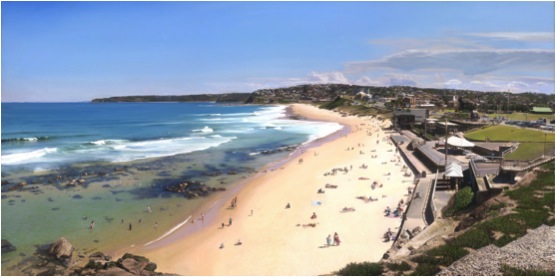
‘Bar Beach to Merewether’
Newcastle is on the coast and not far from Sydney. The majority of you work is bathed in sunshine. Can you expand on this?
It is true that for many years most of my landscapes were painted on a regular sunny day. The last decade especially I have been seeking out more atmospheric options as well from very; very grey storm scenes to dawn and twilight. I will often respond to a subject when I come across it, whatever the circumstances.
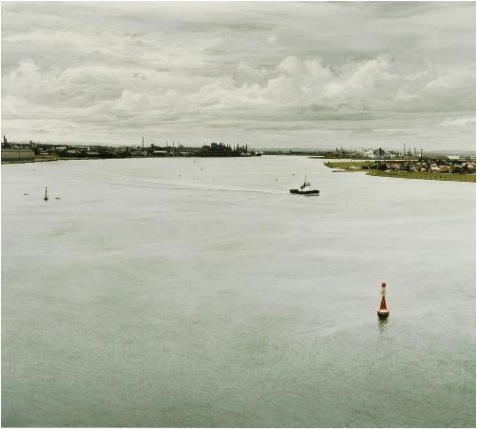
‘Newcastle Harbour’
You paint the iconic images of Sydney. Can you discuss two locations where you have recorded the Sydney CBD?
Many of my paintings of Sydney are around the CBD, the harbour or city Beaches….Neilson Park, Hyde Park….some years ago I did two very large paintings of the city as seen from Vaucluse, the harbour in the foreground. The first was a commission, the vaguely stormy sky was not to the client’s liking, so I painted another which had no spooky sky (it was for a real estate corporation and they had thought the partially grey sky was too indicative of the current real estate market). In the end they preferred the first painting with its extra drama. The second painting sold too.
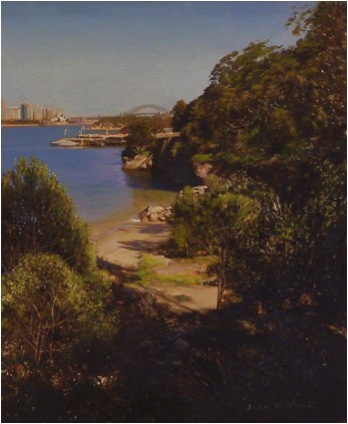
‘Sydney Harbour from Taronga Zoo’
My landscape painting over the years has mainly been of Newcastle and Sydney. The last few years I have been travelling to Melbourne and surrounds, also concentrating on the coast but doing some CBD paintings of that city as well.
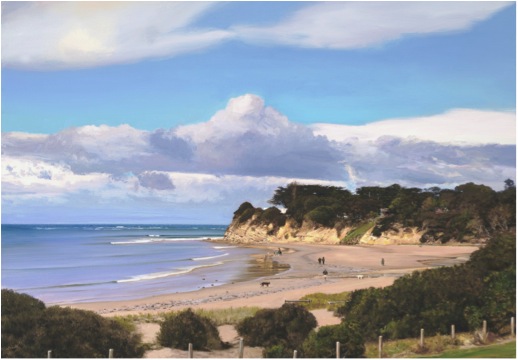
‘Fisherman’s Beach’, Torquay, Victoria’
I guess I represent those subjects that I’m closest to. I’ve always been attracted to the coast and find many good subjects there. The harbour is the same, both Newcastle and Sydney, not a bad starting point with the colour of the water and the boat activity. I really like rural landscape subjects as well but rarely find myself too far from the coast.
Many years ago I drove to Melbourne through country NSW and did paintings of Lake George, Bathurst landscapes and others. I’ve done a few paintings of the Hunter Valley. There is a Glass House Mountains view I keep on meaning to paint, maybe after my next visit to the Sunshine Coast. I’ve painted landscapes of California, London, Bali, the Maldives…. it is just a matter of where I happen to be.
Do you paint ‘en plein air’ or in your studio?
I paint both ‘plein air’ and in my studio. I think that the way a person draws en plein air, or by eye, without any photographic assistance is a good indicator of one’s natural style. I have always drawn quite realistically from life, not like a photo producing machine, but with a kind of classic realism style. The use of photographs in bending this style towards photo realism is something that just happens. I do not aspire to be a photocopy machine, or someone who reproduces photographs in paint. The plein air work or any painting done without the assistance of photographs is to me something that refreshes my realistic landscapes. My taste in art is usually more towards the abstract, not usually realistic landscapes, but there is something about my paintings that seem to go beyond the ordinary. I try to borrow from the great landscape artists that I admire….among them are Lloyd Rees, Conrad Martins, William Delafield Cook, William Turner, William Dobell.
Every decade or so, I leave my landscape painting and spend a few years doing more contemporary, hard edge abstracts and semi abstract paintings and sculptures. Although I very much like this work, which has a dynamic kind of shininess, I sometimes feel that this work can be beautiful, but frivolous there is something about the no-nonsense solemnity of a straight landscape painting that I like. It’s close to impossible for an artist to represent two opposite styles, although I have done so in the past. The next time I show any non- landscape work I will probably do so under a different name, trying to keep the John Earle name as one associated with landscape and realism.
Take us down to the beach there, along with the sunbathers.
Any of my beach scenes are things I’ve seen that appeal to me and that I have represented in a literal fashion.
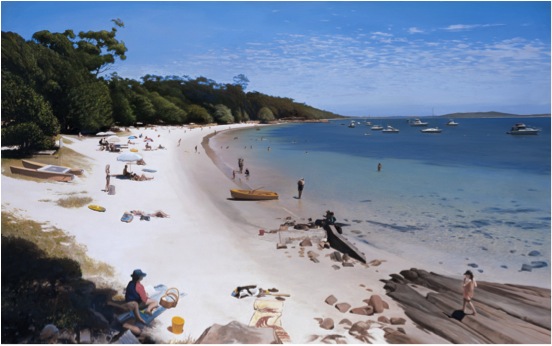
‘Dutchies Beach, Nelson Bay, NSW’
You have also painted ‘Newcastles Children’s Pool’, can you expand on this site?
Looking down on the Newcastle Children’s Pool presents a readymade, ideal landscape composition in a generally oval form. There is usually something interesting in each corner, in the centre and around the periphery.
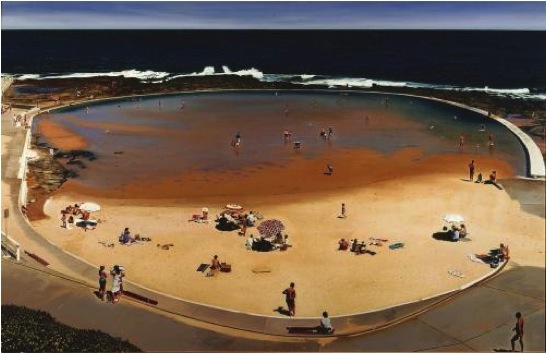
‘Newcastles Children’s Pool’
Water and the coastline are prominent in your paintings. How do you find the right aspect? Please discuss the composition of your work.
I generally look for an elevated aspect whatever the subject. Occasionally I’ll be painting a subject from ground level but I’m always trying to find a bit of elevation from which to view the scene, even if that is just getting on top of a rock to view a scene. The higher you can get usually the composition becomes less horizontal and more squarish, often creating a pleasing composition for a more squarish canvas.
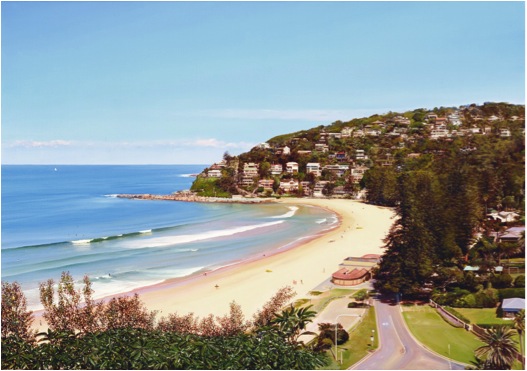
‘Palm Beach, NSW’
Looking at your work, it gives the impression of endless summer days – but the profusion of your work tells another tale. Can you expand on your work day?
Well, hopefully it is ‘endless summer days’, even in winter and when it’s raining, just from the perspective that we all want a nice productive, carefree day whatever the weather. Since my first year of exhibiting paintings in 1981 I have tried to build a regular work practice. Maybe it’s not important for everyone. It’s something that is talked about in most fields of endeavour, but not usually in art. Perhaps the one artist I remember articulating his own work ethic was Salvador Dali. I read some of Dali’s writing whilst still a student and I think that helped me try to put that into practice. There are many artists that work very hard and very well who don’t talk about that but can be an inspiration by example. I’m a very stay-at-home person, more so, in my old age (I’m 58). I have a very nice daily routine of waking up late, making breakfast with coffee, have breakfast in bed watching the news of the day on TV, get any chores of errands done and out of the way, hopefully have a surf or a swim in the ocean and then get to painting in the mid afternoon and knock off sometime after midnight. It’s a routine that I have had for many years and that I enjoy. It simply helps me find the hours that I need to do my work.
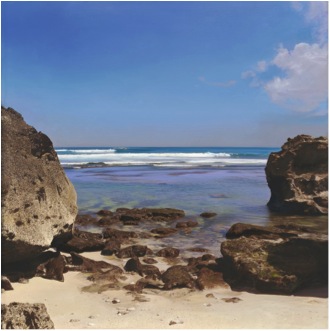
‘Uluwatu, Indonesia’
You sell your work as prints also; can you discuss how you decide on the quantities and sizes of your prints?
As for quantities, I think you want to go for a number that you can completely sell out. There is no point having a massive edition where you wouldn’t sell more than a small percentage. We generally do an edition of 100 to 150 and find that we will sell an edition like that over a few years and then they are gone and will not be repeated. My work can look a bit too photographic if an image of a big painting is reduced to something smaller. These days I am trying to do reproductions of smaller paintings which have been enlarged somewhat, hopefully to where brush strokes have become visible. Even a finely painted original is easy to detect as a painting, but not so easy to do when the image is reproduced on paper or canvas hence some enlargement is an advantage in this way.
With modern technology, colour in prints is so accurate. Has this technology allowed you to extend your paintings into prints?
Yes, the general precision, light fastness and quality papers that are available now allow for a high quality product in reproduction prints. Generally, the colour issues are more complex and not as straight forward as any of the other aspects of making a print. Amanda and I do many proofs and adjustments to settle on something that we are happy to edition. The print is usually its own animal and we don’t so much try to mimic the original as create a print image in its own right, where the colours, etc., are working best as a print.
Do your prints allow you to reach a much broader market?
Prints have been great for us here in Newcastle where my work is known and appreciated the most. Often when I try to introduce my prints to a new market it’s seen as being photography. That has shown me that any prints I make need to be identified as prints of paintings and not photography. So the style of print needs to be right, to fit a certain market. Handmade prints, like screen prints and etchings are a good way to go as well….much more labour intense for a multicolour picture, but always worth the effort.
You have staff in your Gallery. Does this allow you to concentrate on your art?
Although I have had a few studio assistants over the years, my wife and business partner, Amanda Pitcairn and I manage to cover all the bases these days. Our children are grown up now and it’s a very much a two person operation at the Studio. Amanda is instrumental in the production of many things, including the prints. She is typing this now as I speak, what I can’t do she can do and vice versa. It would be very tough working to the same end without the combined efforts of two of us.
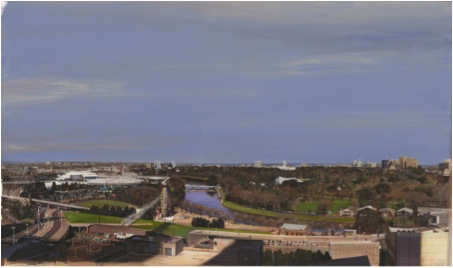
‘Melbourne, CBD’
Can you discuss your “Elioth Gruher Prize for Landscape”, Art Gallery of NSW in 1980 and how prizes can propel an artist’s career?
Yes, that prize – which is for Tertiary Students -helped propel my career. It was my fifth and final year as an art student in 1980 and I was finally producing some good quality canvasses. The prize and some good paintings helped me get started. I was booked in for an exhibition at a quality gallery and the little bit of local publicity like I say, some good paintings helped me kick off with a bit of a bang. At the time there was even a local TV show that reviewed films and arts; I remember a good review of my first show and all that helps. I was picked up by a really good Sydney gallery at that time as well.
Commissions – how, when, and why do you take them on?
Commissioned paintings are a standard part of our business. There is not much I knock back, even just to be helpful….I was touching up an antique clock face recently….I mean, who else is going to take that on? I do remember one painting many years ago where I did as asked, made a painting from a provided photo, made it as good as possible, but it wasn’t much of a painting. I try to make sure that doesn’t occur again….the client may be happy, but I want every painting I do to be better than good, no doubt a few average ones have slipped through. That one may be better than I remember if I see it again.
When do you say “No”?
I say no if it’s not something that I can be proud of, but I will usually try and bend it towards something that is worthy.
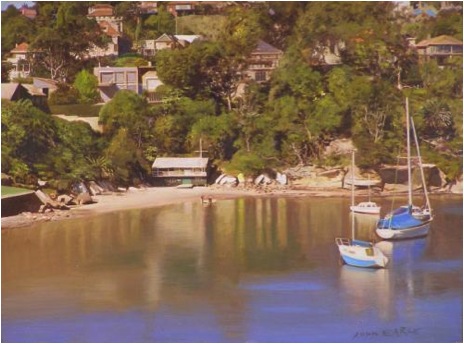
‘Sirius Cove, Sydney’
Your pop surrealism is so different. The focus is on the explosion of colour rather than the dominance of light in your fine art. Is it your way of expressing your gleeful, more impish side?
Yes, the ‘pop surrealist’ works probably reflect best my taste in art for my own walls. It has been my aim to be my own favourite artist, or at least top ten, doing these works has helped me to achieve that. I like and respect my landscape work and want to add what I can to the genre of realistic landscape painting because I don’t see too many other people doing so. Much of the landscape work is homage to early traditional landscape painting that, again, doesn’t seem to be well represented in the contemporary art world. I sometimes think of Goya and his regular gig of portraiture in the Spanish Courts, but what would we think of Goya without his other side….his war drawings and his occult paintings. I think one style builds an appetite for the other.
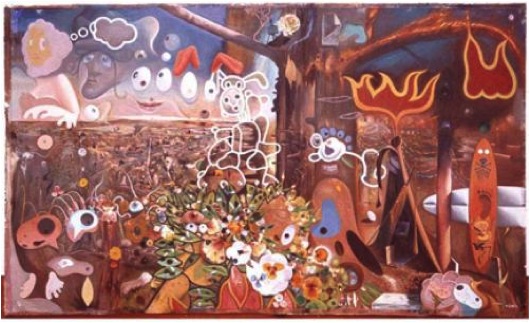
‘Bushfires at Sunset’
Contact details:
J O H N E A R L E S T U D I O G A L L E R Y
126 Glebe Rd, Merewether, NSW, 2291
PH 02 4965 3121![]() 02 4965 3121 | M 0402997231
02 4965 3121 | M 0402997231
Email: johnearle@bigpond.com
Website: www.johnearle.com.au
John Earles, Merewether, NSW, Australia
Interview by Deborah Blakeley, March 2014
Think a colleague or friend could benefit from this interview?
Knowledge is one of the biggest assets in any business. So why not forward this on to your friends and colleagues so they too can start taking advantage of the insightful information the artist has given?
Other artists you may be interested in:


